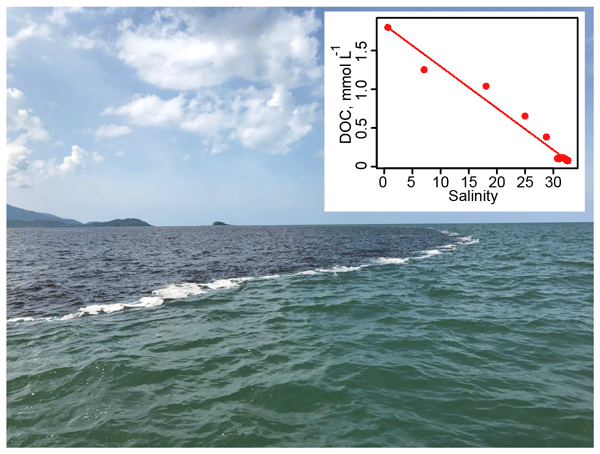Colored dissolved organic matter
Colored Dissolved Organic Matter (CDOM) is a component of the aquatic ecosystem that plays a crucial role in determining the water quality, light penetration, and biogeochemical cycling within both freshwater and marine environments. CDOM, often referred to as gelbstoff, consists of a complex mixture of organic molecules, primarily derived from the decomposition of plant and animal material, as well as from soil leaching. This article delves into the nature, sources, and ecological implications of CDOM in aquatic systems.
Nature and Composition[edit | edit source]
CDOM is characterized by its ability to absorb light, particularly in the ultraviolet (UV) to visible range of the electromagnetic spectrum. This absorption can significantly influence the aquatic light climate, affecting both the thermal structure and primary productivity of water bodies. The composition of CDOM is predominantly made up of high-molecular-weight organic molecules, including humic substances, which are complex mixtures of aromatic and aliphatic compounds. These substances are known for their yellowish-brown color, which is responsible for the coloration of water bodies rich in CDOM.
Sources[edit | edit source]
The primary sources of CDOM are terrestrial inputs, where organic matter from plant and animal decay, as well as soil organic matter, is transported into aquatic systems via runoff and groundwater flow. In coastal areas, the influx of CDOM from rivers can significantly affect the optical properties and ecosystem dynamics of the marine environment. Additionally, in situ production by phytoplankton and other aquatic organisms can contribute to the CDOM pool, although to a lesser extent compared to terrestrial sources.
Ecological Implications[edit | edit source]
CDOM plays a pivotal role in aquatic ecosystems through its influence on light penetration. By absorbing sunlight, CDOM can reduce the depth to which light penetrates into the water, thereby limiting photosynthesis to the upper layers of the water column. This can have profound effects on the distribution of aquatic plants and the structure of aquatic communities. Furthermore, CDOM can protect aquatic organisms from harmful UV radiation by absorbing these wavelengths before they can penetrate deeper into the water.
The presence of CDOM also affects the biogeochemical cycling of elements, particularly carbon, nitrogen, and phosphorus. CDOM can bind with metals, affecting their bioavailability and toxicity to aquatic life. Moreover, the breakdown of CDOM through photodegradation and microbial decomposition releases these elements back into the water column, making them available for biological uptake.
Management and Conservation[edit | edit source]
Understanding the dynamics of CDOM is essential for the management and conservation of aquatic ecosystems. Changes in land use, water pollution, and climate change can alter the quantity and composition of CDOM, with potential implications for water quality, fisheries, and biodiversity. Monitoring and managing the sources of CDOM, such as controlling soil erosion and nutrient runoff, are critical steps in preserving the health and productivity of aquatic environments.
Conclusion[edit | edit source]
Colored Dissolved Organic Matter is a key component of aquatic ecosystems, influencing light penetration, water quality, and biogeochemical processes. Its study is crucial for understanding the functioning of aquatic environments and for the development of effective conservation and management strategies. As research continues to unravel the complexities of CDOM, it will provide valuable insights into the interplay between terrestrial and aquatic systems and the impacts of human activities on these vital ecosystems.
Search WikiMD
Ad.Tired of being Overweight? Try W8MD's NYC physician weight loss.
Semaglutide (Ozempic / Wegovy and Tirzepatide (Mounjaro / Zepbound) available. Call 718 946 5500.
Advertise on WikiMD
|
WikiMD's Wellness Encyclopedia |
| Let Food Be Thy Medicine Medicine Thy Food - Hippocrates |
Translate this page: - East Asian
中文,
日本,
한국어,
South Asian
हिन्दी,
தமிழ்,
తెలుగు,
Urdu,
ಕನ್ನಡ,
Southeast Asian
Indonesian,
Vietnamese,
Thai,
မြန်မာဘာသာ,
বাংলা
European
español,
Deutsch,
français,
Greek,
português do Brasil,
polski,
română,
русский,
Nederlands,
norsk,
svenska,
suomi,
Italian
Middle Eastern & African
عربى,
Turkish,
Persian,
Hebrew,
Afrikaans,
isiZulu,
Kiswahili,
Other
Bulgarian,
Hungarian,
Czech,
Swedish,
മലയാളം,
मराठी,
ਪੰਜਾਬੀ,
ગુજરાતી,
Portuguese,
Ukrainian
Medical Disclaimer: WikiMD is not a substitute for professional medical advice. The information on WikiMD is provided as an information resource only, may be incorrect, outdated or misleading, and is not to be used or relied on for any diagnostic or treatment purposes. Please consult your health care provider before making any healthcare decisions or for guidance about a specific medical condition. WikiMD expressly disclaims responsibility, and shall have no liability, for any damages, loss, injury, or liability whatsoever suffered as a result of your reliance on the information contained in this site. By visiting this site you agree to the foregoing terms and conditions, which may from time to time be changed or supplemented by WikiMD. If you do not agree to the foregoing terms and conditions, you should not enter or use this site. See full disclaimer.
Credits:Most images are courtesy of Wikimedia commons, and templates, categories Wikipedia, licensed under CC BY SA or similar.
Contributors: Prab R. Tumpati, MD


